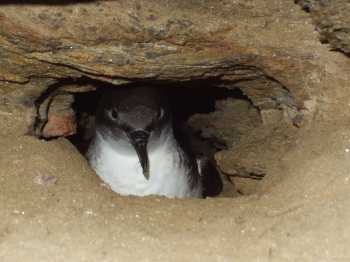Karen Bourgeois (School of Biological Sciences, Auckland University, New Zealand) and colleagues have published in the journal Acta Ornithologica on site and mate selection in the Vulnerable Yelkouan Shearwater Puffinus yelkouan, a candidate species for ACAP listing.
The paper’s abstract follows:
“Nest and mate choice is important in seabirds, influencing reproductive performance as both nest-site and partner quality varies. The Yelkouan Shearwater Puffinus yelkouan nests mainly in pre-existing cavities and to a lesser extent in cavities it excavates. We have monitored breeding colonies of the Yelkouan Shearwater on two islands of the Hyères archipelago, south-east of France, for nine years to analyse nest-cavity and mate selection, to evaluate nest-cavity and mate fidelity, and to investigate their relationships with reproductive performance. Yelkouan Shearwaters selected nest-cavities providing a high degree of concealment and protection. Reproductive performance and fidelity to cavity were highest in deep cavities with a winding tunnel and a steep slope around the entrance. Mating was assortative for bill and tarsus measurements. High rates of return to the same cavity (94.7%) and mate (95.5%) were recorded. Fidelity to nest-cavity was highest when breeding succeeded the previous year (fidelity rate: 97.3% in successful breeders vs. 87.8% in unsuccessful breeders) and was most likely to result in successful breeding the same year (breeding success: 67.5% in faithful breeders vs. 43.8% in movers). The rate of divorce was low (4.5%), did not differ between islands and was not associated with breeding performance. However, breeding success increased by 22.2 ± 9.9% after mate change following a divorce or the absence of a previous mate. Such high rates of nest-cavity and mate fidelity could indicate a good population status with breeding habitat, food resource and mates of good quality.”

Yelkouan Shearwater, photograph by Jerome Lagrand
With thanks to Karen Bourgeois for information.
Reference:
Bourgeois, K., Dromzée, S. & Vidal, E. 2014. Relationships between nest-cavity and mate selection, reproductive performance and fidelity in the Mediterranean endemic Yelkouan Shearwater Puffinus yelkouan. Acta Ornithologica 49: 9-22.
John Cooper, ACAP Information Officer, 10 August 2014

 English
English  Français
Français  Español
Español 

